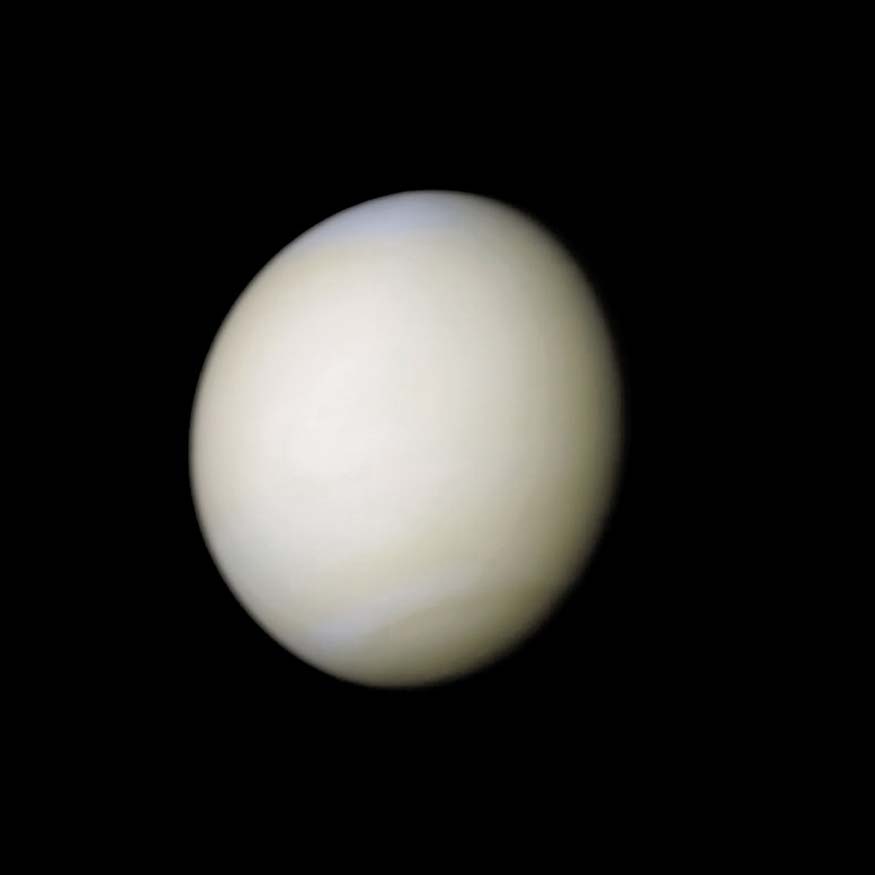
BEAUTY: 
BRAGGING RIGHTS: You saw the planet closest to the Earth
HOW EASY IS IT TO SEE? Best with a small telescope
TYPE: Planet
DISCOVERED: Known since antiquity
Shining low on the horizon, brighter than any other planet, Venus seems beautiful and peaceful. The Babylonians called it Nin-dar-anna—“Mistress of the Heavens.” The Greeks and Romans associated it with the goddess of love. Alas, appearances deceive: the bright clouds of Venus are made of sulfuric acid, and the temperature at its surface is more than 900 °F. Venus is more like hell than paradise.
Early in the twentieth century, scientists imagined Venus as Earth’s twin. After all, it is roughly the same size and was known to have a thick atmosphere, unlike the dead moon or cold and deserted Mars. Swedish Nobel prizewinner, Svante Arrhenius, imagined it as a jungle world, hotter than Earth because of its closeness to the sun, but still habitable.
If that had been true, we might be looking for life on Venus instead of Mars. By the 1960s, however, Russian and American space probes revealed the truth: the surface of Venus is hot enough to melt lead. Dreams of living on Venus vanished.
Nevertheless, a puzzle remained: why was Venus so hot? Venus is farther from the sun than Mercury, but it’s hotter than it is. Why? In the 1970s, scientists discovered the answer: Venus’s thick atmosphere, which is composed mostly of carbon dioxide, traps the heat from the sun, causing a greenhouse effect.
WHAT YOU MIGHT SEE THROUGH AMATEUR EQUIPMENT
Today when you look up at Venus you can see it for what it really is: not a goddess or a jungle world, but a real world. A hostile world, to be sure, but one filled with many mysteries and, possibly, a few lessons for our own planet Earth.
You’ve probably seen Venus already. Maybe you saw a bright star one day at sunset coming home from work. Or maybe you saw a morning star before dawn. If it wasn’t a plane, it was probably Venus.
Venus orbits closer to the sun than the Earth does, which means you’ll never see it too far from the sun in the sky. Consult the table on the next page for dates when Venus will be visible.
You’ll need binoculars or a small telescope to see the phases of Venus. Though pictures of Venus show cloud patterns, you won’t see anything except a bright, featureless disk. Nevertheless, seeing the big crescent of Venus shining in the twilight can be an unforgettable experience.
Phases of Venus. From our perspective, we see Venus in one of three positions, depending on where it is in its orbit. When it is on the opposite side of the sun from us, Venus is brightly lit—like a full moon—but it is so far away that we only see a tiny disk.
When Venus is on the same side of the sun as us, it is much closer. Unfortunately, because sunlight is shining behind it, we only see a thin crescent. Nevertheless, because it is so close, the crescent will appear relatively large—even bigger than Jupiter. This is a great time to see Venus.
Finally, Venus can be on one side of its orbit, so it appears half-lit. From our perspective it will appear far from the sun, staying above the horizon long after sunset.
Just like the moon, part of the fun of watching Venus is seeing it pass through its phases night after night. Of course, you’ll have to wait longer: whereas the moon completes a cycle in just over 29 days, Venus takes 584 days.
Venus in daytime. Venus is so bright that it is sometimes visible during the day. You just need to know where to look!
Wait for a day when Venus is far to one side of the sun—otherwise it will be lost in the sun’s glare. Find Venus just after sunset and try to remember its rough distance away from the sun. The next day, wait for the sun to get lower in the sky and see if you can spot Venus before sunset. Once you get familiar with where Venus is in the sky relative to the sun, it will be easier to find, even in broad daylight.
|
WHEN TO SPOT VENUS |
|
DATE |
When |
June 4, 2017 |
Morning before sunrise |
August 18, 2018 |
Evening after sunset |
January 6, 2019 |
Morning before sunrise |
March 25, 2020 |
Evening after sunset |
August 13, 2020 |
Morning before sunrise |
October 30, 2021 |
Evening after sunset |
March 20, 2022 |
Morning before sunrise |
January 4, 2023 |
Evening after sunset |
October 24, 2023 |
Morning before sunrise |
January 10, 2025 |
Evening after sunset |
June 1, 2025 |
Morning before sunrise |
August 16, 2026 |
Evening after sunset |
January 4, 2027 |
Morning before sunrise |